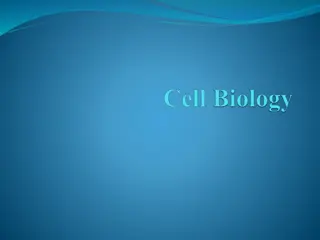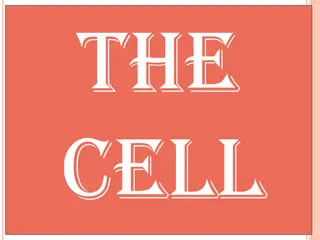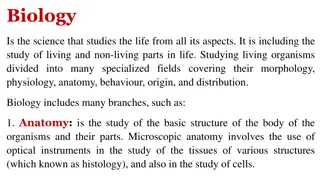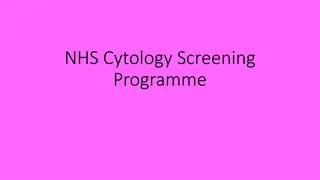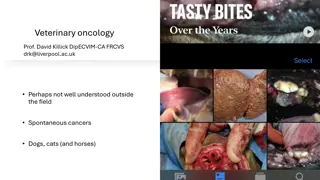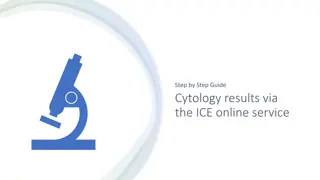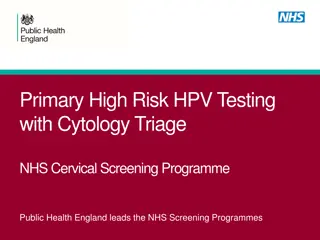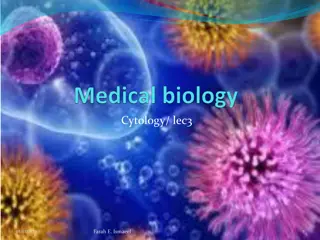Cytology Lec2
Cell membrane transport plays a vital role in maintaining cell function. The membrane is selectively permeable, allowing certain molecules to pass through while blocking others. Permeable molecules include small hydrophobic and uncharged polar molecules, while non-permeable molecules include large uncharged polar molecules and ions. Molecules cross the membrane through passive (simple diffusion, channel diffusion, facilitated diffusion) and active (active transport, endocytosis, exocytosis) mechanisms. Osmosis involves the movement of water molecules across a semi-permeable membrane. Channel diffusion is a type of passive transport system that involves the movement of ions using channel proteins.
Download Presentation

Please find below an Image/Link to download the presentation.
The content on the website is provided AS IS for your information and personal use only. It may not be sold, licensed, or shared on other websites without obtaining consent from the author.If you encounter any issues during the download, it is possible that the publisher has removed the file from their server.
You are allowed to download the files provided on this website for personal or commercial use, subject to the condition that they are used lawfully. All files are the property of their respective owners.
The content on the website is provided AS IS for your information and personal use only. It may not be sold, licensed, or shared on other websites without obtaining consent from the author.
E N D
Presentation Transcript
Cytology Lec2 25 03 1 BY FARAH E. ISMAEEL
Cell membrane transport Cell membrane or plasma membrane is selectively permeable membrane also regarded as differentially permeable membrane or semi permeable membrane, because is allow some molecules pass through it while prevent other molecule from passing. 25 03 2 BY FARAH E. ISMAEEL
Permeable molecules to the cell membrane include: small hydrophobic molecule like O2, CO2, N2 and benzene. And small uncharged polar molecules like water, glycerol and ethanol. Non permeable molecules to the cell membrane include: large uncharged polar molecules like sugar, amino acids. And Ions like H+, Na+, K+, Cl , Ca++, Mg++, HCO3 25 03 3 BY FARAH E. ISMAEEL
Molecules cross the plasma membrane in 2 ways: Passive ways: no energy used. Include: 1. simple diffusion. 2. channel diffusion . 3. facilitated diffusion. Active ways: use energy. Include: 1. active transport. 2. endocytosis 3. exocytosis. 25 03 4 BY FARAH E. ISMAEEL
Simple diffusion the movement of molecules from higher concentration to lower concentration, until they are distributed equally for examples water, gases, glycerol, ethanol diffuse simply through the plasma membrane 25 03 5 BY FARAH E. ISMAEEL
25 03 6 BY FARAH E. ISMAEEL
osmosis the movement of water molecules through semi-permeable membrane from a solution with a low solute concentration to a solution with a higher solute concentration until there is an equal solute concentration on both sides of the membrane. 25 03 7 BY FARAH E. ISMAEEL
25 03 8 BY FARAH E. ISMAEEL
Channel diffusion Channel diffusion this type of passive transport system also don t use energy, used for movement of Ions (H- or Cl-) required only channel protein. 25 03 9 BY FARAH E. ISMAEEL
25 03 10 BY FARAH E. ISMAEEL
Facilitated diffusion Facilitated diffusion another type of passive transport system doesn t use energy but required a carrier protein assist the movement of glucose or amino acids. Each protein carrier, sometimes called a transporter, binds only to a particular molecule, such as glucose. 25 03 11 BY FARAH E. ISMAEEL
25 03 12 BY FARAH E. ISMAEEL
25 03 13 BY FARAH E. ISMAEEL
Medical application On simple diffusion Type 2 diabetes mellitus results when cells lack a sufficient number of glucose transporters. 25 03 14 BY FARAH E. ISMAEEL
Active ways energy used 25 03 15 BY FARAH E. ISMAEEL
Active transport molecules and ions can be transported across cell membrane against their concentration gradient appropriate transport proteins and a source of energy (ATP) areavailable. Proteins involved in active transport often are called pumps if the 25 03 16 BY FARAH E. ISMAEEL
Examples on active transport water pump uses energy to move water against the force of gravity; energy is used to move substances against their concentration gradients. Sodium-Potassium Pump is transport protein (pump) in the plasma membrane that moves sodium ions (Na+) out of and potassium ions (K+) into animal cells; important in nerve and muscle cells. 25 03 17 BY FARAH E. ISMAEEL
25 03 18 BY FARAH E. ISMAEEL
25 03 19 BY FARAH E. ISMAEEL
Medical application On active transport Cystic fibrosis is a genetic disorder occurs when there is a defects in a gene on chromosome 7 .This gene, called CFTR (cystic fibrosis Transmembrane conductance regulator), codes for the CFTR protein is a channel protein that controls the flow of H2O and Cl- ions in and out of cells inside the lungs. When the CFTR protein is working correctly, ions freely flow in and out of the cells. However, when the CFTR protein is malfunctioning, these ions cannot flow out of the cell due to a blocked channel. This causes cystic fibrosis, characterized by the buildup of thick mucus in the lungs. 25 03 20 BY FARAH E. ISMAEEL
25 03 21 BY FARAH E. ISMAEEL
CF CF Specialty Medical genetics Symptoms Difficulty breathing, coughing up mucus, poor growth, fatty stool, Clubbing in the fingers of a person with cystic fibrosis Usual onset Symptoms recognizable ~6 month Long term Genetic (autosomal recessive) Sweat test, genetic testing Duration Causes Diagnostic method Treatment Antibiotics, pancreatic enzyme replacement, lung transplantation Life expectancy 42 and 50 years (developed world) 1 in 3,000 (Northern European) Prognosis Frequency 25 03 22 BY FARAH E. ISMAEEL
Endocytosis Uptake process of molecules and transport it across cell membrane into the cell interior by vesicle formation, a portion of the plasma membrane invaginates to envelop the substance, and then the membrane pinches off to form an intracellular vesicle. There are three methods of endocytosis: Phagocytosis 2. Pinocytosis 3. Receptor- mediated endocytosis 1. 25 03 23 BY FARAH E. ISMAEEL
25 03 24 BY FARAH E. ISMAEEL
25 03 25 BY FARAH E. ISMAEEL
Medical application On endocytosis An inherited form of cardiovascular disease occurs when cells fail to take up a combined lipoprotein and cholesterol molecule from the blood by receptor- mediated endocytosis. Also one type of dwarfism are caused by nonfunctioning growth hormone receptors, In this condition the gland produce the hormone, but the target cells cannot respond because they lack normal receptors. 25 03 26 BY FARAH E. ISMAEEL
Exocytosis Release process of material from the cell. During exocytosis vesicles often formed by Golgi apparatus and carrying a specific molecule fused with plasma membrane and secretion occurs. e.g. release of insulin molecules from beta cells. 25 03 27 BY FARAH E. ISMAEEL
25 03 28 BY FARAH E. ISMAEEL
Cell membrane specialization The lateral parts of the cell membrane can show several specializations that form "intercellular junctions" 25 03 29 BY FARAH E. ISMAEEL
functions of intercellular intercellular junctions junctions 1. Sites of adhesion between adjacent cells. 2. Prevent the flow of materials through the intercellular compartment. 3. Help in the intercellular communication. 25 03 30 BY FARAH E. ISMAEEL
The three main types of cell junctions in human cells is 25 03 31 BY FARAH E. ISMAEEL
25 03 32 BY FARAH E. ISMAEEL
Functions of plasma membrane Protecta cell by acting as a barrier between cell contents and surrounding environment. 2. Regulate the movement of substances in and out of a cell. It allows the passage of substance selectively in order to maintain a constant cell environment a phenomenon called homeostasis. 3. Connect cells together in specific way by cell junctions and pass on information to neighboring cell, so that the activities of tissue and organs are coordinated. 4. Serve as the attachment surface for many extracellular structures. 03 25 BY FARAH E. ISMAEEL 1. 33
25 03 34 BY FARAH E. ISMAEEL



